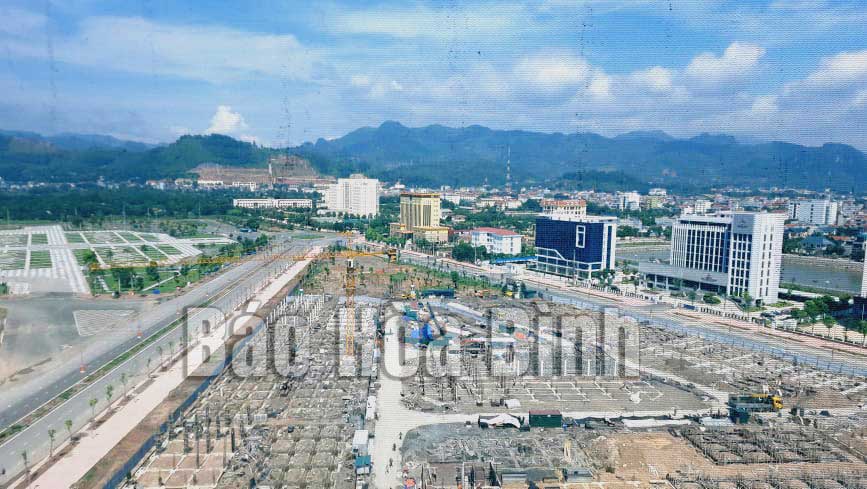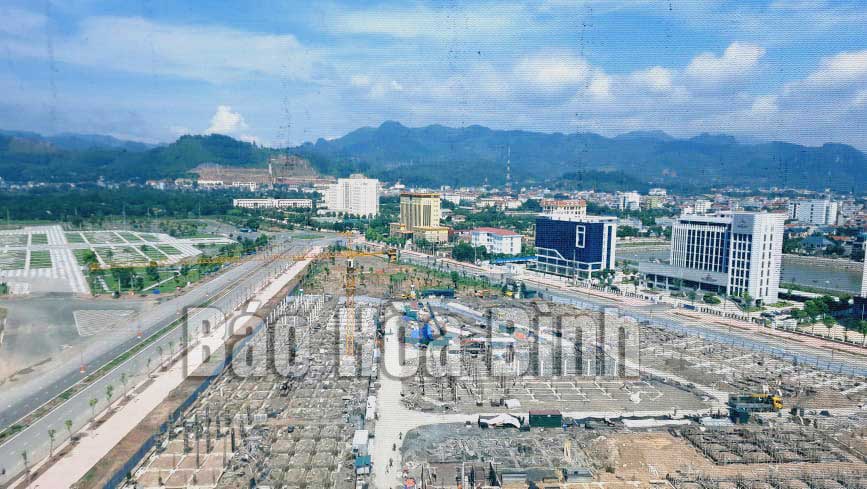
(HBO) - Hoa Binh city is the political, administrative, economic and cultural centre of Hoa Binh province. From a peaceful town in the Northwest mountainous region, the city has to date made great strides in many fields. The synchronous implementation of many solutions over the years has given the city a facelift, thus affirming the advantages, potential and value of a new developing urban area

Hoa Binh city is on the way of development, creating
a dynamic and modern urban appearance.
According to Bui Quang Diep, Chairman of the city People's
Committee, after merging Ky Son district into Hoa Binh city, the city now has a
natural area of more than 348sq.km, and a population of about 135,700.
The synchronous investment in transport infrastructure and
technical infrastructure, along with the mobilization of many resources, has
enabled the city to grow in many fields, and achieve remarkable progress,
especially in economic development. Industry and services are developing day by
day, and many industrial zones and clusters have been established, attracting
ten thousands of local workers.
According to statistics of the city People's Committee, the
city has recorded an annual average economic growth rate at nearly 7.6 percent
in recent years. Locals' lives and social welfare and social security and order
are ensured, and environmental protection has improved. In 2020, the per capita
income reached over 66 million VND; the rate of poor households was about 1.28
percent and over 90 percent of locals joined health insurance.
In the first six months of 2021, the total value of
industrial and handicraft production hit 2.85 trillion VND, up 25.8 percent
year-on-year. The city is also preparing the conditions to start construction
on technical infrastructure for the Cham Mat – Dan Chu industrial park and Tien
Tien industrial clusters, while continuing to accelerate the ground clearance
for other industrial zones and clusters to attract investment. Local budget
revenue is estimated at 627.83 billion VND, equal to 63.4 percent of the target
set in the city People’s Council's resolution. Currently, the city is managing
96 projects funded by public investment, with a total capital of over 3.07
trillion VND.
To implement the resolution of the city Party Congress for
the 2020-2025 term, Diep said that the city has built a specific action
programme on investment in infrastructure of type-II urban areas in connection
with service development.
At the same time, Hoa Binh city will work to fully tap local
potential and advantages, preserve and promote national cultural identity, well
implement social welfare, improve locals’ living conditions, and maintain
political security and social order and safety. It is striving to complete the
criteria for turning the city into a type-II urban area before 2025, and
achieve an average growth rate of production value of 19 percent for the
five-year period to 2025./.
According to data from the Hoa Binh Provincial Party Committee, the industrial production index for the first six months of 2025 is estimated to have increased by 20% compared to the same period last year. This marks the highest year-on-year growth rate for this period since 2020.
In the first six months of 2025, Hoa Binh province’s export turnover was estimated at 1.145 billion USD, marking an 18.11% increase compared to the same period in 2024. Import turnover was estimated at $ 804 million, a 17.15% increase, which helped the province maintain a positive trade balance.
The lives of the ethnic minority farmers in Tan Lac district have gradually improved thanks to the new directions in agricultural production. This is a testament to the collective strength fostered through the professional associations and groups implemented by various levels of the district’s Farmers’ Union.
With the motto the "product quality comes first,” after nearly one year of establishment and operation, Muong village’s Clean Food Agricultural and Commercial Cooperative, located in Cau Hamlet, Hung Son Commune (Kim Boi district), has launched reputable, high-quality agricultural products to the market that are well-received by consumers. The products such as Muong village’s pork sausage, salt-cured chicken, and salt-cured pork hocks have gradually carved out a place in the market and they are on the path to obtaining the OCOP certification.
In the past, the phrase "bumper harvest, rock-bottom prices" was a familiar refrain for Vietnamese farmers engaged in fragmented, small-scale agriculture. But today, a new spirit is emerging across rural areas of Hoa Binh province - one of collaboration, organisation, and collective economic models that provide a stable foundation for production.
Maintaining growing area codes and packing facility codes in accordance with regulations is a mandatory requirement for agricultural products to be eligible for export. Recently, the Department of Agriculture and Environment of Hoa Binh province has intensified technical supervision of designated farming areas and packing facilities to safeguard the "green passport" that enables its products to access international markets.



